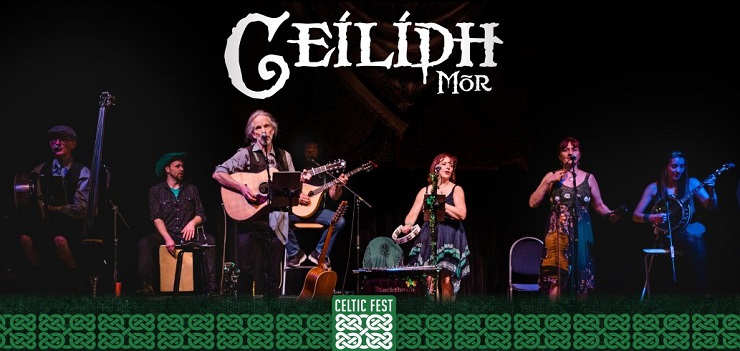WITH LUCK OF THE IRISH A CEILIDH COULD SAVE DUNN’S PAVILION
STEPHEN RICHARDS | Special to MuskokaTODAY.com FICTION
101 Entrance Drive, North Falls: March 10, 1912
Over the past nine years, scrutchers, weavers, warpers, menders and finishing experts arrived via the Sagamo steamer, departing from places such as Ulster, Lisburn and Belfast. Each seeking opportunities free from famine and hoping for improved working conditions.
And, if lucky, love and companionship.
Their destination? Dominion Linen Mills. The only factory in Canada, according to J.D. Shaw, specializing in fine linens, canvas, seamless bags, towelling, rope twine and something called “tribbles.”
Hardcoeur Fenton Cyrano-Jones, a Pennsylvania Dutch emigrant, had visions of exporting fine Irish linens to British colonies to bypass certain trade restrictions and profit from the cotton shortage. He set out on his journey from the stripes and stars on a five-year trek, passing through Waterloo County where flax is grown and in search of the ideal site to build his enterprise where no man has built before.
The building he constructed in 1903 in North Falls (now Bracebridge) had sufficient water power to run 25 looms and ancillary equipment; and was ideally situated with a Northern Railway rail siding, proximity to the docks in Bracebridge Bay and the Muskoka Colonization Road. He handpicked the 50 or so employees, primarily women of Irish descent, for their expertise in the art of flax dressing.
It’s break time
The air is charged with excitement as the big day looms. An Irish celebration of music, dance, and food replicated here for the first time.
Caitlan Smyth, Aine West, Brianna Orr and Oonagh Kelly are seated in the back corner near the rail door, munching on ‘Venus Drugs and Confections’© cranberry scones, sipping Irish breakfast tea and observing Finnegan Lobaircin, a diminutive deaf man in green coveralls, erect a stage for the upcoming St. Patricks’s Day ceilidh.
At an adjacent table, George Simmons (conductor of the Irish Weavers Citizen Band) and Fenton are discussing the music program and the guest performers. Some songs mentioned included ‘Be Thou my Vision’, ‘The Blackbird of Belfast Laugh’, ‘Celtic Air’ and ‘Songs of the Scribe.’
“The program should contain a balance of reels, hornpipes and double jigs, with a smattering of classical music and … marches,” says George. “Let’s feature Turlough O’Carolan, Patrick Byrne, Tarlach Mac Suibhne and some John Field, Handel and Claude Villiers Sandford.”
Fenton pulls a swashbuckling move to appease some of his associate business partner’s cling-ons, and has already booked guest performers including Planxty (‘Jolly Beggar Reel’), Vin Moore-Ryan (‘Gloria, The Potatoes Ain’t Lookin’ so Good’) and the Ulster’s 1st Regiment a.k.a. ‘U1’ to play ‘Beautiful Day — Sunday Bloody Sunday Medley.’
Fenton mentions he will ask his staff to bring traditional instruments, such as an Irish fiddle, Irish flute, uilleann pipes, concertina, harp and of course some bodhrans. One can never have enough bodhrans.
Once the plans have been finalized, coinciding with the end of break, only Finnegan remains and can be seen kneeling on the tracks facing the stage shimming it level.
Locomotive 105 (‘Tech Lugus’) — ironically nicknamed “The Leprechaun” — is the largest engine in Northern Railway’s fleet. The shiny silver smoke stack is decorated with a green shamrock. The cabin is adorned with a spear painted on one side and a sling on the other side.
The Leprechaun left New Berlin that morning with a long load of flax from the previous season’s harvest, as well as lumber, black smith tools, medicine and books. The steam engine received a particularly high grade of coke, which powered the engine to almost mythical proportions. The supercharged locomotive reached Muskoka in record time. The engineer plied the brakes to no avail and dangerously barreled around the corner speeding down Dominion Linen’s rail siding.
Wile E. Fox, the engineer, blasts the horn to no avail “’cause Finnegan can’t hear.”
The train derails and slides forward on its side with its momentum crushing the stage before finally coming to a rest in front of the rail doors and resting “Due North.”

Musicians Friend, 100 years later: March 10, 2012
Bart Neely is restocking the shelves of the Musicians Friend music store with reeds, swabs, oils, guitar picks and what-not, while whistling ‘O’Carolan’s Farewell.’ He is day-dreaming and it’s quite vivid. He’s walking down Manitoba Street scanning the signage of the local shops: Bird Woolen Mill, Beardmore Tannery, Anglo Canadian Leather, Thomas McMurray Paper and MacMillan Millners.
His boss, Marley Kim is standing in front of him watching his lips mouth “WW McKinsey Store.” She has been asking him if he’s OK, but got no response.
Finally, she shakes him and asks: “What gives? You’re acting strangely.”
He emerges from his reverie, looks her in the eye: “What do you know about Dominion Linen and the train accident a century ago?”
“I will tell you tonight at Kelly’s Pub, in Bracebridge,” Marley replies.
That evening in Bracebridge (Formerly known as North Falls)
Bart and Marley had a wonderful dinner at Kelly’s Pub. Bart had the Irish Stew, Marley the Shepherd’s Pie. They shared a pint of Guinness, an unfamiliar rich dark beer so unlike a Coors Lite.
Marley revealed all she knew about the train accident, while walking over to the Foundry, formerly the Dominion Linen Mill, now an entertainment complex complete with a microbrewery, pub, coffee roaster and bakery.
Off they putted along in a 1974 robin’s egg blue AMC (Brampton, Canada) Gremlin-Pacer to the Foundry, parking across the length of four spots. They pass through the main entrance and make their way to the back corner, observing the 1950s ceilings, a stage, lots of entertainment gear and seating for 380. The back drop is a large rail door with the image of Locomotive 105 emblazed on it, shamrocks on either side and ‘The Leprechaun’ stenciled above.
Desmond, Bart’s Maine Coon cat, suddenly yowls as the rail door screeches open. There is a whoosh. The air is bone chilling. Bright lights blaze from a large lamp dead ahead. A fog drifts in. Lightning flashes and suddenly thunder booms. Two people and what appears to be a child are backlit. The little one lets out a cackling laugh.
Paul Emil Breitenfeld emerges out of thin air, seated in a front row seat in familiar cross-legged style. Standing beside him is a small man wearing green overalls.
To the wee man, Paul says: “You didn’t have to make such a dramatic entrance. You frightened them needlessly.”
Paul introduces Finnegan Lobaircin to Bart.
“Finnegan has a wish. Due to an unfortunate accident, an important celebration never happened back on St. Patrick’s Day, 1912. And he would like you to put one on here. Can you make it happen?”
Then the familiar figure of Gerry Dunn steps forward and the spotlight dims.
“Bart, you need to use the proceeds to save the Dunn Pavilion in Bala,” says Bart, who looks over at his uncle’s apparition. “That doesn’t leave a lot of time to put it together.”
“Do it” says Paul. “It’s important — and be quick!”
The fog dissipates as do the apparitions.
Marley asks who Bart was talking to.
“Ummm. Myself? I’ve been thinking. We need to put together a concert. For St. Patrick’s Day. Are you game?”
Marley, always up to a challenge, replies: “Sounds like fun. Let me call my peeps” and pulls out her iPhone going through the contact list.
“We will need food, musicians, marketing, sponsorship … and the help of ‘e-Claire.’”
Bart looks up to see Gerry, Finnegan and Uncle Paul giving him the thumbs up, fading out to the sound of the jingle, jangle of sleigh bells.
TO BE CONTINUED …
Steve Richards is a Muskoka musician and writer who prefers Guinness to Coors Lite.
